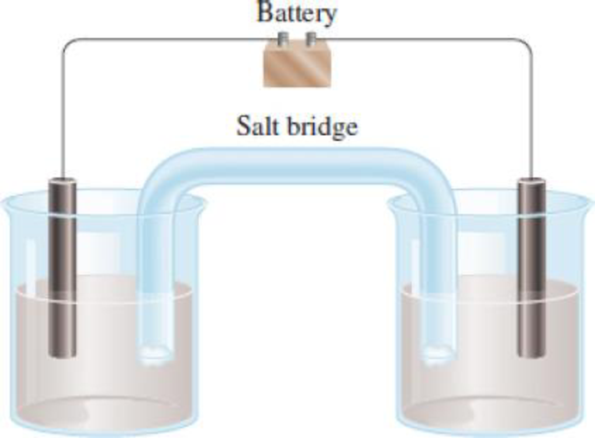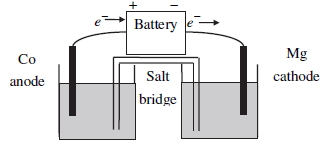
Concept explainers
The diagram here shows an electrolytic cell consisting of a Co electrode in a 2.0 M Co(NO3)2 solution and a Mg electrode in a 2.0 M Mg(NO3)2 solution. (a) Label the anode and cathode and show the half-cell reactions. Also label the signs (+ or −) on the battery terminals. (b) What is the minimum voltage to drive the reaction? (c) After the passage of 10.0 A for 2.00 h the battery is replaced with a voltmeter and the electrolytic cell now becomes a galvanic cell. Calculate Ecell. Assume volumes to remain constant at 1.00 L in each compartment.

a)
Interpretation:
Half reactions; the anode and cathode have to be labelled.
Concept introduction:
Standard reduction potential: The voltage associated with a reduction reaction at an electrode when all solutes are 1M and all gases are at 1 atm. The hydrogen electrode is called the standard hydrogen electrode (SHE).
Standard emf:
Where both
Thermodynamics of redox reactions:
The change in free-energy represents the maximum amount of useful work that can be obtained in a reaction:
Relation between
Relation between
Effect of concentration on cell Emf:
The mathematical relationship between the emf of galvanic cell and the concentration of reactants and products in a redox reaction under nonstandard-state conditions is,
As known
Dividing by –nF, the above equation becomes,
Nernst equation: The Nernst equation is used to calculate the cell voltage under nonstandard-state conditions.
Explanation of Solution

Figure.1
For the given redox reactions,
In the galvanic cell, Oxidation occurs at anode and reduction occurs at cathode.
Therefore,
Anode (Oxidation):
Cathode (Reduction):
b)
Interpretation:
The minimum voltage needed to drive the reaction has to be calculated.
Concept introduction:
Standard reduction potential: The voltage associated with a reduction reaction at an electrode when all solutes are 1M and all gases are at 1 atm. The hydrogen electrode is called the standard hydrogen electrode (SHE).
Standard emf:
Where both
Explanation of Solution
The emf values for the two given half-reactions are,
Anode (Oxidation):
Cathode (Reduction):
Calculated standard emf for galvanic cell as follows,
The minimum voltage needed to drive the reaction is
c)
Interpretation:
The emf of a given galvanic cell has to be calculated.
Concept introduction:
Standard reduction potential: The voltage associated with a reduction reaction at an electrode when all solutes are 1M and all gases are at 1 atm. The hydrogen electrode is called the standard hydrogen electrode (SHE).
Standard emf:
Where both
Effect of concentration on cell Emf:
The mathematical relationship between the emf of galvanic cell and the concentration of reactants and products in a redox reaction under nonstandard-state conditions is,
As known
Dividing by –nF, the above equation becomes,
Nernst equation: The Nernst equation is used to calculate the cell voltage under nonstandard-state conditions.
Explanation of Solution
Given: Current= 10.0 A; Time,
Convert Current into coulomb:
As known,
Convert number of Coulombs into mole of electrons:
Convert mole of electrons into number of moles:
1 mole of Cobalt
‘X’of Cobalt =
Therefore, no.of moles of Cobalt is
Assuming solution volumes of 1.00L, the concentration of Co2+ in solution after 2hours is 2.373 M, and the concentration of Mg2+ in solution after 2 hours is 1.627 M. we use the Nernst equation to solve for
Calculation of non-standard emf value using Nernst equation:
The reaction quotient for the given reaction is,
The concentration of pure solids and pure liquids do not appear in the expression for Q.
Hence, the reaction quotient becomes,
Substitute known constant values of R, T and F into Nernst equation becomes as follows,
The number of electrons transferred in the given redox reaction is TWO (n=2) and
The emf of the given cell reaction is
Want to see more full solutions like this?
Chapter 18 Solutions
Chemistry
- While noble gas exerts the strongest London (dispersion) forces on neighboring atoms? Group of answer choices Xe Ar Kr Nearrow_forwardWhich of the following elements is corrosive to your skin due to that element breaking down C=C bonds? Group of answer choices fluorine iodine bromine chlorinearrow_forwardWhat the best source of sulfide to use on a small scale in the lab? Group of answer choices thiourea H2S NaHS Na2Sarrow_forward
- Which of the following statements about sulfur is FALSE? Group of answer choices H2S is the product of an oxygen-depleted ecosystem. In the acid mine drainage reaction, FeS2 is a product. One allotrope of sulfur has the formula S20. In the environment, bacterial oxidation can convert S2− to elemental S or SO42−.arrow_forwardOf the following choices, which is the best reason that most materials DON'T spontaneously combust even though our atmosphere is about 21% oxygen? Group of answer choices The reduction of O2 in the gas phase (O2 + e− → O2−) is spontaneous. The reduction of O2 in acid solution (O2 + H+ + e− → HO2(aq)) is spontaneous. O2 is not a reactant in combustion. The O2 bond dissociation energy is 494 kJ/mol, leading to a high activation energy for combustion.arrow_forwardplease answer in the scope of the SCH4U course, I am having a hard time understanding, may you show all steps please and thank you! can you also put the final answers in the table so its understandablearrow_forward
- Plan the synthesis of the following compound using the starting material provided and any other reagents needed as long as carbon based reagents have 3 carbons or less. Either the retrosynthesis or the forward synthesis (mechanisms are not required but will be graded if provided) will be accepted if all necessary reagents and intermediates are shown (solvents and temperature requirements are not needed unless specifically involved in the reaction, i.e. DMSO in the Swem oxidation or heat in the KMnO4 oxidation). There may be more than one correct answer, and chemically correct steps will be accepted. Extra points will be given if correct names are provided. The points earned here will be applied to your lowest exam score! H Harrow_forwardDraw the mechanism to make the alcohol 1-hexanol. Please use arrows.arrow_forwardAnswer the followings: 1-What is the difference(s) between DNA and RNA: a- Structure: b- Function: c- Types: 2-What is the meaning of: a- Replication b- Transcription c- Translation 3- Show the base pair connection (hydrogen bond) in DNA and RNAarrow_forward
- Why does the anhydride react with the OH on the benzene rather than the OH on the carboxy group?arrow_forwardAnswer the followings: 1- What is the IP for a amino acid? Give example. 2- What are the types of amino acids? 3- What are the structures of protein? 4- The N-Terminal analysis by the Edman method shows saralasin contains sarcosine at the N- terminus. Partial hydrolysis of saralasin with dilute hydrochloric acid yields the following fragments: Tyr-Val-His Sar-Arg-Val His-Pro-Ala Val-Tyr-Val Arg-Val-Tyr What is the structure of saralasin? 5. MATCH a term from the list below to each definition. Place the letter of the term in the blank to the left of the definition. a. Ligases b. Fibrous proteins c. Conjugated protein d. Hydrolases a. b. C. e. Simple protein f. Globular proteins g. Lyases h. Transferases Proteins that are tough and insoluble in water. Enzymes that catalyze the breaking away of a small molecule such as from a substrate. Enzymes that catalyze the bonding together of two substrates.arrow_forwardAnswer the followings (Four): 1-What is the difference(s) between FOUR: a. Glyceride and phosphoglyceride. b. Wax and fat. c. Soap and fatty acid. d. HDL and LDL cholesterol e. Phospho lipids and sphingosine. 2-What are the types of lipids? 3-What are the main lipid components of membrane structures? 4-How could lipids play important rules as signaling molecules and building units? 5. The Structure variety of Lipids makes them to play significant rules in our body. Conclude briefly on this statement.arrow_forward
 General Chemistry - Standalone book (MindTap Cour...ChemistryISBN:9781305580343Author:Steven D. Gammon, Ebbing, Darrell Ebbing, Steven D., Darrell; Gammon, Darrell Ebbing; Steven D. Gammon, Darrell D.; Gammon, Ebbing; Steven D. Gammon; DarrellPublisher:Cengage LearningChemistry: Matter and ChangeChemistryISBN:9780078746376Author:Dinah Zike, Laurel Dingrando, Nicholas Hainen, Cheryl WistromPublisher:Glencoe/McGraw-Hill School Pub Co
General Chemistry - Standalone book (MindTap Cour...ChemistryISBN:9781305580343Author:Steven D. Gammon, Ebbing, Darrell Ebbing, Steven D., Darrell; Gammon, Darrell Ebbing; Steven D. Gammon, Darrell D.; Gammon, Ebbing; Steven D. Gammon; DarrellPublisher:Cengage LearningChemistry: Matter and ChangeChemistryISBN:9780078746376Author:Dinah Zike, Laurel Dingrando, Nicholas Hainen, Cheryl WistromPublisher:Glencoe/McGraw-Hill School Pub Co Principles of Modern ChemistryChemistryISBN:9781305079113Author:David W. Oxtoby, H. Pat Gillis, Laurie J. ButlerPublisher:Cengage Learning
Principles of Modern ChemistryChemistryISBN:9781305079113Author:David W. Oxtoby, H. Pat Gillis, Laurie J. ButlerPublisher:Cengage Learning Chemistry by OpenStax (2015-05-04)ChemistryISBN:9781938168390Author:Klaus Theopold, Richard H Langley, Paul Flowers, William R. Robinson, Mark BlaserPublisher:OpenStax
Chemistry by OpenStax (2015-05-04)ChemistryISBN:9781938168390Author:Klaus Theopold, Richard H Langley, Paul Flowers, William R. Robinson, Mark BlaserPublisher:OpenStax Chemistry: Principles and ReactionsChemistryISBN:9781305079373Author:William L. Masterton, Cecile N. HurleyPublisher:Cengage Learning
Chemistry: Principles and ReactionsChemistryISBN:9781305079373Author:William L. Masterton, Cecile N. HurleyPublisher:Cengage Learning





